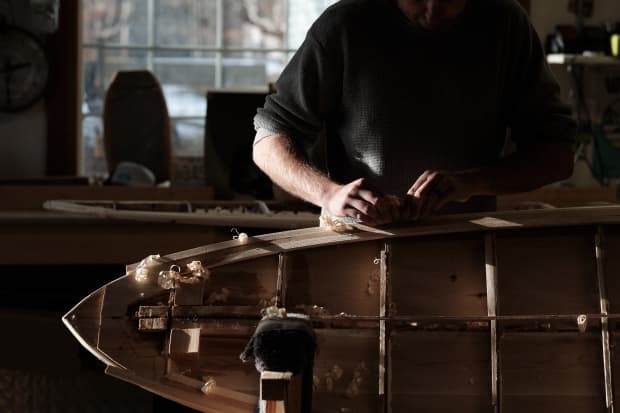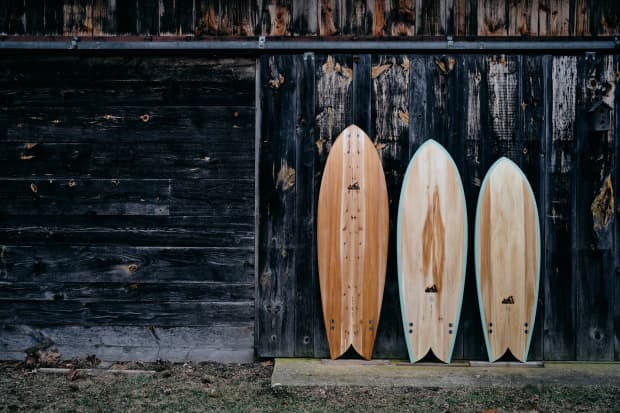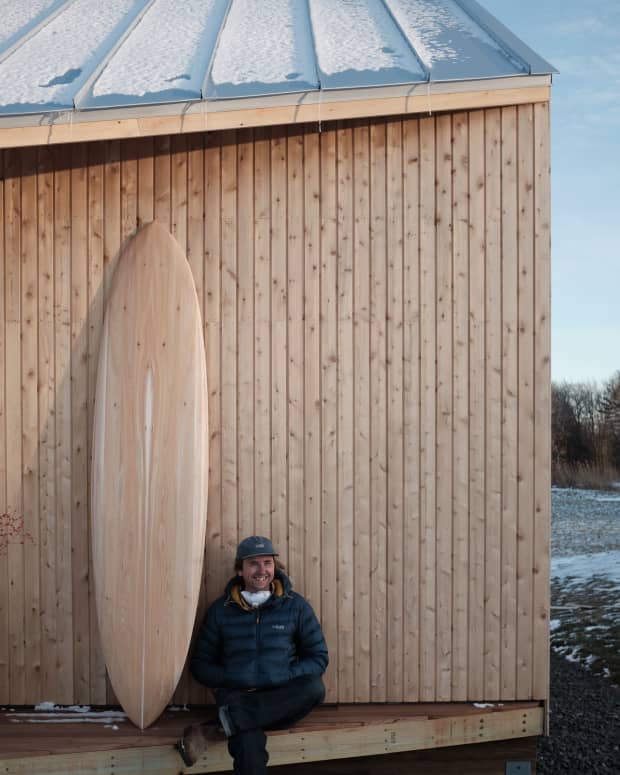Building a wood surfboard with Maine’s Grain Surfboards
Making a surfboard from foam is of course very cool, but it does not have the tradition of “whiskey planks,” which means it will forever be inferior to the process of building a wooden surfboard. Whiskey planks is a shipbuilding thing, technically, a celebration when two crucial parts of the boat are joined, I forget which parts. At Grain Surfboards though, when it was time to join the deck and bottom of a wooden board I’d been building for a couple of days, we glued the suckers together, then me and the handful of other people in their workshop gathered around a bottle of Glenfiddich and tipped back shots. Whiskey planks. Then it was back to work.
Grain Surfboards is one of my favorite places in the world. It’s a small workshop dedicated to teaching folks how to build wooden surfboards, according to the age-old Maine tradition of deep affection for woodcraft, which makes sense because founder Mike LaVecchia was once a boat builder. It’s on a square plot of land in the adorable New England town of York, Maine. York has a big crescent-shaped slice of beach with decent waves when the sandbars align, and a grab bag of reefs and cobblestone points that come alive when proper swell is aimed the right direction.

Nick LaVecchia
I was there a couple of winters ago, during a frigid week everybody in Maine described as “nice.” I stayed in the nearby town of Portsmouth, across the border in New Hampshire, the kind of ancient colonial brick town I’d only ever read about in history books. At night I’d go to a pub, order a bowl of clam chowder and a mug of beer and half expected a man in a tri-corner hat would be roaming the cobblestone streets ringing a bell to announce some important colonial gathering. It snowed every night I was there, and was so far removed from anything resembling a surf town, the very idea of surfing seemed a zillion miles away. Except in Grain’s cozy little surf cabin.
I built a 7’11” Thick Lizzy—a Ryan Lovelace template—part of the board design catalog Grain offered. The whole process took about three days. If you’ve ever made a foam board, you should know making one from wood is essentially the exact opposite. With foam, you stand there in front of a big fat blank, and somewhere in there is the board you want to end up with. Your job is to carve away the excess foam until you’re left with something close to what you’d envisioned starting out. Wood is the exact opposite. You build it from nothing. You gather a big pile of wood struts and strips and planks—Grain uses local cedar—and put them together until they’re a surfboard. There are approximately 8 million more steps in making a wood board, almost none of which are intuitive.
First, you basically glue everything together from the inside out. Then you get to work with incredible little woodworking tools. There’s the spokeshave, a blade encased in a metal body with two wood handles that you pull toward yourself to shave round curves into hard edges. A drawknife is like a scythe with handles on both ends, used for peeling away great nautilus-like spirals of wood. Most of my work was done with a palm-sized brass block plane—a Lie-Nielsen model—that made a satisfying tthhhwwwiiippp sound as it curled thin strips of cedar. I flattened rough surfaces with a heavy chisel, the cedar parting like warm butter. Once finished, the board is glassed, but not before you get to sign your name to it with a needle-tipped branding iron, which is badass. At that point, it’s a surfboard like any other. A touch heavier than foam, but infinitely more beautiful. And because of the grain, totally unique.

Nick LaVecchia
The board surfs like a dream, too. Yeah, it’s heavier than foam, but it feels more pure somehow. Similar to the way a P/U board feels more pliant and alive underfoot than an epoxy board does. Maybe it’s because I’m approaching middle age now, but I don’t remotely care about ultimate performance anymore. The aesthetics and feel of the wood board are just better than foam. It’s like baseball. Aluminum bats are undoubtedly higher performance than wood bats, but there’s just something romantic and human and alive about wood bats.
My Thick Lizzy is a single fin, and loves being surfed from the back half of the board, noodling around in the pocket, before coming off the bottom with authority to project up to the top of the wave. I surf it whenever the waves are around shoulder high with some push. Locking into a high line on this wooden board I made with my own hands feels like nothing else. There really isn’t a turn you could do out there on a high-tech foam board that would beat that feeling.
Grain’s gotten more and more popular over the years and classes fill up quickly. Especially for their new Green Rail boards, which use recycled plastic on the rails, saving time and money (shaping the rails was by far the most grueling part of making my all-wood board, so I get it).

Nick LaVecchia
Last time I talked to Mike, they had some slots open this year in their 4-day classes. You can also order the kits to build a board at home, which I plan to do later this year. If you invest in a few of the woodworking tools, it’s totally doable once you’ve been guided first by someone who knows what they’re doing, or if you’re already a great woodworker.
If I was planning a surf trip with some friends somewhere, I’d highly consider changing things up and booking a Grain workshop in the late fall when the water is still survivable and there’s a decent chance of swell. You can surf after the class, drink some local beers at night, and when the shop’s over, you take home an incredibly beautiful board you’ll have forever.

